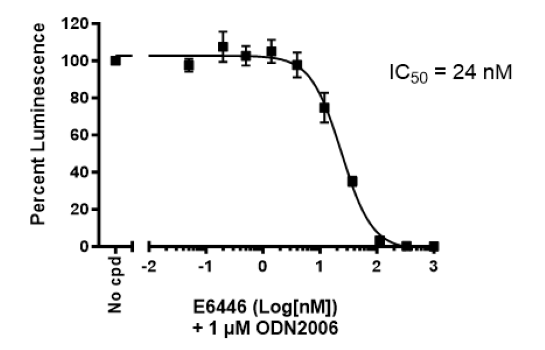TLR9/NF-κB Reporter – HEK293 Recombinant Cell Line
TLR9/NF-κB Luciferase Reporter HEK293 Cell Line is a HEK293 cell line expressing firefly luciferase under the control of NF-κB response elements with constitutive expression of human TLR9 (Toll-like receptor 9) (GenBank Accession No. NM_017442), a member of the toll-like receptor (TLR) family.
Interested in screening and profiling inhibitors, blocking antibodies, or activators of TLR9 without the need to purchase and license the cell line? Check out our Cell Signaling Pathway Screening.
Purchase of this cell line is for research purposes only; commercial use requires a separate license. View the full terms and conditions.
Media Required for Cell Culture
| Name | Ordering Information |
| Thaw Medium 1 | BPS Bioscience #60187 |
| Growth Medium 1A | BPS Bioscience #79528 |
Materials Required for Cellular Assay
| Name | Ordering Information |
| ODN2006 | Invivogen tlr1-2006 |
| E6446 dihydrochloride | Selleckchem #S6719 |
| 96-well tissue culture treated white clear-bottom assay plate | Corning #3610 |
| ONE-Step™ Luciferase Assay System | BPS Bioscience #60690 |
| Luminometer |
The cell line has been screened to confirm the absence of Mycoplasma species.
The family of Toll-like receptors (TLRs) acts as primary sensors that detect a wide variety of microbial components and elicit innate immune responses. Human TLR9 (toll-like receptor 9), also known as CD289 (cluster of differentiation 289), is expressed in cells in immune cells, such as dendritic cells, macrophages and NK cells. It can be found in endosomes, where it recognizes specific unmethylated CpG DNA motifs prevalent in microbial but not vertebrate genomic DNA, leading to innate and acquired immune responses. Stimulation of TLR9 triggers its movement to the Golgi and lysosomes and interaction with MyD88. This interaction activates a signaling cascade that leads to the activation of the transcription factor NF-κB, which controls the expression of an array of inflammatory cytokines. TLR9 has been identified as a major player in systemic lupus erythematosus (SLE) and erythema nodosum leprosum (ENL). TLR9 has also been linked to cancer, with breast and renal cell carcinoma having lower expression levels, while prostate cancer and glioma showing higher levels. TLR9 agonists, such as SDS-101 and tilsotolimod, are currently being tested in the clinic as combination cancer therapies. Further studies into the molecular pathways involved TLR9 and development of agonists can open new avenues for the treatment of TRL9-linked diseases.



